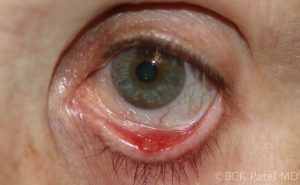What are the differences between a stye, a chalazion, an internal hordeolum and an external hordeolum?
Home / Orbit, Eyelids, and Lacrimal System
Contributors: BCK Patel MD, FRCS, Jay Patel BSC, Raman Malhotra FRC
Photographer: BCK Patel MD, FRCS
When an area of inflammation is seen along the eyelid margin or within an eyelid, the terms stye, chalazion, internal hordeolum and external hordeolum are frequently used interchangeably. This is incorrect as each term describes a specific type of lesion and appearance.
In order to understand the differences between these four conditions, it is important to understand the cross-sectional anatomy of the eyelid:
- Meibomian glands are glands within the tarsus of the upper eyelid and the lower eyelid. There are up to 30 such glands in the upper eyelid and 25 in the lower eyelid. They produce an oily substance called meibum which reduces the rate of evaporation of the tear film. They are exocrine glands, meaning they have ducts that secrete their contents via ducts that open at the eyelid margin. They are also holocrine glands because the secretions result from lysis of the secretory glands, thereby releasing the oily substance into the duct.

Fig. 2. Cross section of the upper eyelid showing the relationship of the Meibomian gland to the orbicularis oculi muscle and the eyelashes at the eyelid margin. The Meibomian glands open at the posterior part of the eyelid margin
- Glands of Zeis are also holocrine sebaceous oil glands that open into the middle portion of the hair follicle. There are one to two glands of Zeis per eyelash. The sebum they produce serves to stop the eyelashes from becoming brittle. A mildly moist sheen is formed on healthy eyelashes.

Fig 3. Cross-section depiction of the eyelid margin showing the relationshop of the Meibomian gland, the eyelashes and the glands of Zeis and Moll
- There are up to 150 eyelashes on the upper eyelid and up to 80 eyelashes on the lower eyelid. They generally grow in two layers, with the posterior layer being finer. One to five lashes are lost in a 24 hour period as lashes go through growth cycles.
Definitions:
A. Stye
A stye is caused by an infection of the gland of Zeis which opens into the eyelash follicle. Therefore, the clinical appearance will be one of erythema around the root of an eyelash. If there is active infection, there will be a yellowish-red appearance. External hordeolum is another term for a stye.

Fig 4. A stye or external hordeolum is an infection of the gland of Zeis which opens into the eyelash follicle. There will be erythema around the eyelash follicle with local tenderness
B. Chalazion
A chalazion is caused by an obstructed Meibomian gland. The retained sebaceous secretions cause enlargement and can cause local irritation with secondary non-infective granulomatous inflammation: lipogranulomatous material is present within the gland. The appearance is one of an enlarged Meibomian gland usually without tenderness and often presents as a cosmetic concern. A chalazion is also called a tarsal cyst or Meibomian cyst.
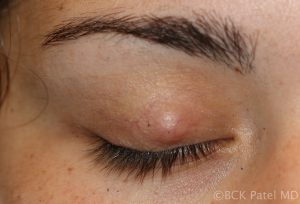
Fig 5. A Chalazion with swelling of a Meibomian gland caused by retained lipogranulomatous material in a blocked Meibomian gland. Simple chalazia tend to be non-tender but will be firm to palpation
Secondary inflammation or infection can cause local tenderness.
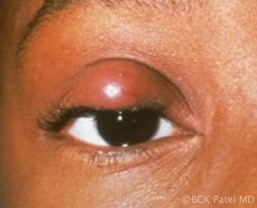
Fig 6. A Chalazion with erythema caused by secondary infection of the blocked Meibomian gland. These will be tender to the touch
C. Internal hordeolum
When a blocked Meibomian gland becomes inflamed with or without infection, it can “point” posteriorly with a yellowish appearance on the tarsal conjunctiva. These are generally termed “internal hordeola”.

Fig 7. Internal hordeolum: the inflamed or infected Meibomian gland points posteriorly and a yellow surface is seen on the tarsal conjunctival surface where the lesion points.
D. Internal hordeolum with granuloma
The inflamed or infected lipogranulomatous material can cause a local granuloma, similar to a pyogenic granuloma.
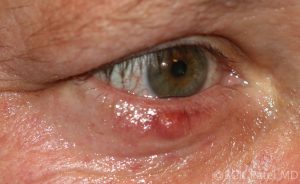
Fig 9. An inflamed or infected chalazion can point outwards. Although the term “external hordeolum” is usually reserved for infections of the glands of Zeis, this term is frequently also used for such an outward-pointing inflamed chalazion.
E. Chronic chalazion
A chronically blocked Meibomian gland can result in a firm nodule in the eyelid. By using the term “chronic chalazion”, the firmness and chronicity of such lesions can be recognized.
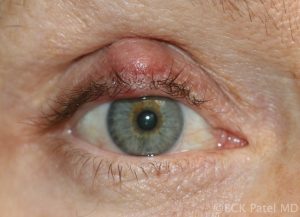
Fig 11. Chronic Meibomian gland cyst (chalazion) without local infection or inflammation resulting in a persistent, firm nodular lesion
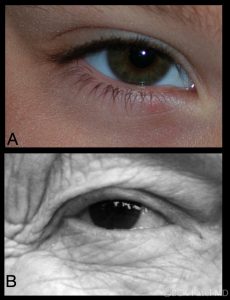
Fig 12. Aging of the eyelids and eyelashes: Generalized thinning of the tarsal plates with atrophy of the Meibomian glands and decrease in the density of eyelashes
References
- Jordan GA, Beier K. Chalazion. StatPearls, Treasure Island (FL): StatPearls Publishing. Aug 2021. https://pubmed.ncbi.nlm.nih.gov/29763064/ PMID:29763064
- WillmannD, Guier CP, Patel BCK,, Melanson SW. Stye. StatPearls, Treasure Island (FL): StatPearls Publishing. Aug 2021. https://pubmed.ncbi.nlm.nih.gov/29083787/ PMID:29083787
- Patel BCK, Joos ZP. Diseases of the eyelashes. StatPearls, Treasure Island (FL): StatPearls Publishing. Aug 2021. https://pubmed.ncbi.nlm.nih.gov/30725785/ PMID:30725785




